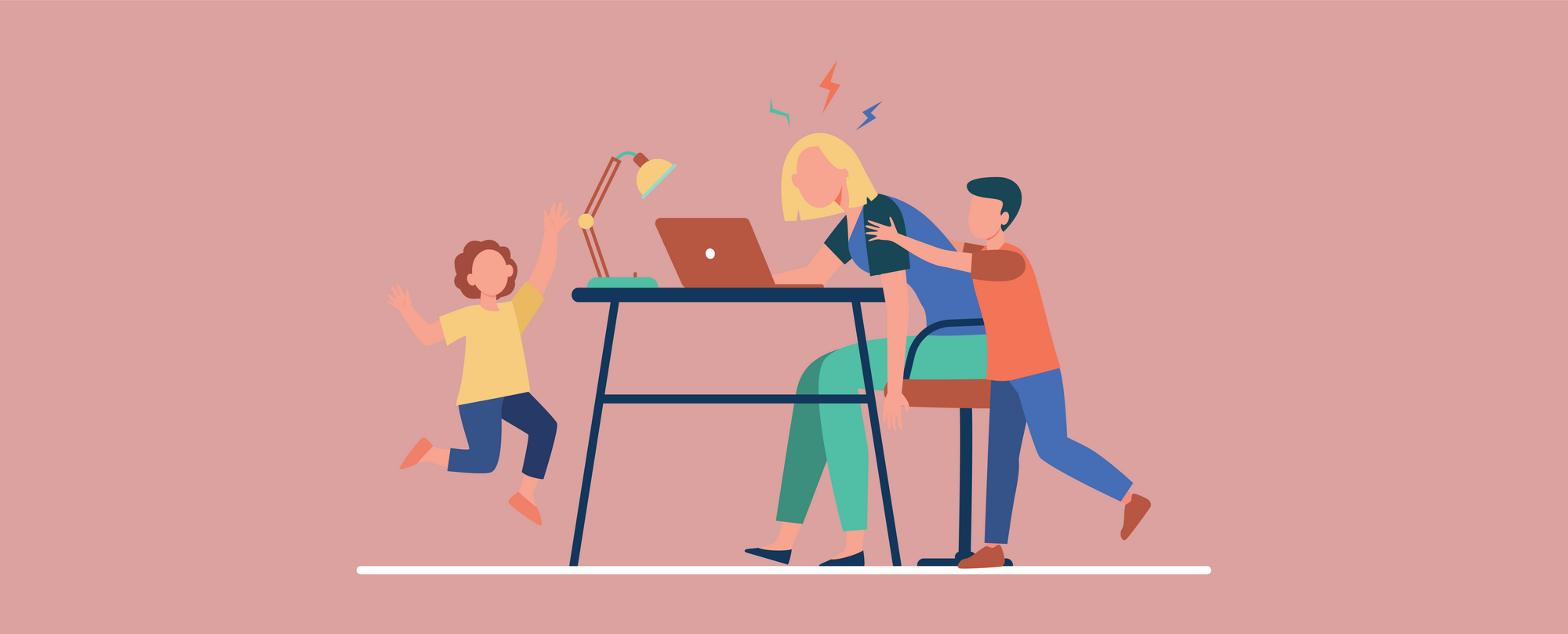How To Get Rid of Distractions While Working from Home
No Credit Card Required.

Working from home poses a myriad of challenges, but distractions are perhaps one of the biggest that we constantly need to overcome. Whether it's other people, children, that load of laundry that needs doing, or simply trying to adapt to the work/life balance in the home environment, there are so many ways our attention is diverted.
Distractions can have a myriad of negative impacts on your work performance, your ability to keep to deadlines and schedules, and the quality of your output. Here’s how to minimize and eliminate distractions at home to ensure that you can always perform at your peak during work hours.

8 Ways to Eliminate Work From Home Distractions and Improve Your Focus
1. Identify your biggest distractions
Knowing your primary distractions can assist you in minimizing them as much as possible before your workday begins. If you know that a messy kitchen will distract you if you fail to clean it before you start work, do your household chores first thing in the morning or the evening before work. This way, they won’t divert your energy from the work that you’ve scheduled for an allotted time frame.
Likewise, if your children tend to distract you frequently while you are trying to work, set rules and boundaries with them about your office space and your work time. Let them know they shouldn’t approach you during work unless there is an emergency. Most importantly, ensure that they have other activities lined up to keep them entertained while you are busy.
One of the best ways to identify your biggest distractions is to write out a list and prioritize these distractions from most disruptive to least disruptive. Focus on the distractions that you can change, and create rules and strategies around how you plan to counter or address them. It’s a good idea to be aware of your own weaknesses to ensure that you can govern yourself while you work from home.
If you struggle to remain productive at home, there’s nothing wrong with incentivizing yourself to do so. Create tempting rewards that you can enjoy when you complete certain projects or tasks. Looking forward to a reward can motivate you to work consistently hard until you have achieved your goals for each day.
2. Set up a dedicated office space
Setting up a dedicated home office in your house is easier said than done. Not everyone is lucky enough to have the luxury of a large living space and a dedicated home office. It isn’t always easy to dedicate a specific portion of your home to work, especially if you stay in an apartment or a small home.
However, it’s imperative that you find a small area that you can dedicate to your work activities and restrict distractions within. When you’re in that space, you should only focus on work activities, and likewise, no work activities should take place outside of that space. This will help you to enforce a clear distinction between your home and leisure space and your work environment.
Having a home office set up in your bedroom isn’t recommended unless this is absolutely necessary. Doing so can blur the lines between work and rest. It may also impact your sleeping patterns by signalling to your brain that it should be focusing on work activities in the bedroom rather than winding down for sleep.
A better alternative is to set up your home office in a spare bedroom, in your living room, or even in an attic or basement if you have one. This will allow you to reserve your bedroom for relaxation and sleep, rather than blurring the lines between sleep and work.
3. Establish boundaries
Do external demands, like in-office meetings, coworkers’ schedules, and other people’s requirements, usually dictate your own work schedule? Do you find yourself putting off your work until the last minute because your coworkers want to have long personal discussions and you don’t have the heart to stop them? If so, you may need to enforce stricter boundaries while working remotely. This will ensure that you spend your time wisely during traditional work hours without becoming burned out or overwhelmed.
Identify the best aspects of your past physical office that suited you the most, and then try to adapt them to your home-based work environment. You could organize your home office in a more functional way, limit the time you spend speaking to coworkers about non-work-related topics, and let your family and friends know when you would prefer not to be disturbed.
According to Productivity Pro founder Laura Stack, personal quirks are crucial to setting healthy work boundaries. She recommends creating and maintaining boundaries that align with your personality and allow you to function at your best without hindering your potential.
It’s also recommended that you identify the times at which you are naturally the most productive and eager to work. If you work most efficiently at midday, save meetings and periods of intense work for the midday period. Fill your mornings and afternoons with other, less crucial tasks. Cross off your day’s goals as you meet them too.
4. Maintain a schedule
Clearly attributing time for work responsibilities and tasks is an excellent way to prioritize your work and limit your distractions. If you break down each day into defined and purposeful blocks of time, you are far less likely to become distracted or to procrastinate on completing important projects.
To excel at maintaining a schedule, it’s important to allow yourself time to focus on work and to tend to your own personal and social responsibilities. Fill each day with a healthy combination of practical check-ins with your colleagues and managers. Include time to chat with coworkers and collaborate with your peers as well. Chatting to them will ensure that you remain a valued and active member of your work team, and make team projects and collaboration easier to fulfil when the time comes.
Remote work tends to eliminate the ability to casually interact with your colleagues, so you will very likely need to be more intentional about keeping in touch. Use popular collaborative communication tools like Zoom, Slack or Google Hangouts to achieve this. You should also schedule a time to spend socializing with friends, family members, and loved ones to maintain a sustainable work-life balance.
5. Use time-tracking software
Time tracking software is one of the best tools you can employ to streamline your remote work schedule and keep track of how much time you spend on certain tasks. Digital apps like Apploye offer a host of time tracking and work management tools, including task management, and projects & budgeting features. They also include remote employee monitoring with screenshots, invoicing tools, payroll software, team and admin management tools, and more.

Apploye’s convenient mobile app allows you to track time spent on work from your mobile device. You can clock in and out for attendance with a single tap, track time spent on job sites and projects, and even track your staff’s real-time locations if you have employees to manage. These tools can streamline your day-to-day work responsibilities and keep all the tools, features, and data you need in a single, centralized location.
Additionally, Apploye offers actionable insights into your productivity levels, which allows you to optimize your approach to working from home and maximize your outputs. The software automatically keeps track of your project progress, provides progress assertion records and efficiency graphs, and encourages you to boost your productivity levels around every turn. This freelancer time tracking app will help you to keep meticulous records of your time spent on projects to ensure that you can bill your clients as accurately as possible.
6. Manage your devices
Smartphones, tablets, and social media are all highly distracting at the best of times, and even more so in work environments. Listening to emails, messages, Netflix recommendations, and other notifications come through every few minutes would distract even the most disciplined of workers. If you tend to reach for your phone as soon as you become stressed or bored, it’s essential to manage your access to devices intelligently to work more efficiently from home.
It can be particularly challenging to do this while you are at home, as this is where you would naturally be free to use your smartphone or tablet under normal circumstances. You will need to maintain a high level of discipline to keep these distractions locked away during work hours, just as you would at your physical office. Try storing devices in a lockable drawer or another room while you need to concentrate, or alternatively, consider turning your Wi-Fi off altogether when you need to focus more deeply.
7. Create a visual calendar
Visual organization tools like visual calendars can help you to stay organized, particularly if you are easily distracted at home. Even a simple whiteboard is useful for writing down and keeping track of to-do lists and project requirements, while sticky notes can remind you of which tasks need your attention on any given day. Brainstorming charts are another excellent way of keeping visual track of your responsibilities at work. Plus, they allow for plenty of creativity in terms of how you display and memorize these tasks.
If you struggle to use daily planners and notepads, you could consider using a digital tool. An online calendar or virtual task list is a great option for keeping track of all of your responsibilities across all of your devices in a centralized way. Most of these apps can sync across your desktop and mobile devices, ensuring that you will always have access to your calendar entries, whether you are at home or on the go.
8. Curate your workspace
Experts recommend curating your workspace to remove distractions and make it as comfortable as possible. Kit out your setup with comfortable office furniture, paperwork storage facilities, printers, stationery, and anything else you need to work efficiently. Use these items to replace potentially distracting items like clocks, toys, televisions, radios, and hobby materials.
It’s an excellent idea to keep your workspace highly organized too. Prevent papers and clutter from piling up by regularly cleaning your work area, filing paperwork, and shredding or disposing of unneeded documents. Always remove superfluous items like used coffee cups, old snack packets and the likes. Your brain will function better in an organized environment and is less likely to become overstimulated if there is no clutter in sight. Clutter has marked negative impacts on our short-term memory and cognitive abilities. Removing it will help to ensure that you can give work tasks your full attention.
Ergonomics is another essential consideration for remote workers. Having a healthy work setting means supporting your posture with a good quality work chair, properly arranged screens, and a desk that sits at the right height for your needs.
It also means ensuring that you have plenty of natural daylight illuminating your workspace to regulate the amount of the sleep hormone melatonin that your brain produces. The healthier you eat, sleep and live, the better equipped you’ll be to perform at work. So, investing in an ergonomic office can pay off significantly in the long run.

The Bottom Line
Working from home brings many benefits, including more flexible work schedules, a more comfortable setting, and less travel and commuting requirements. However, it may also bring numerous challenges and distractions that you will need to overcome if you want to remain productive while you work.
The initial transition from working in an office space to working at home can be a tricky one. It’s potentially even more distracting if you don’t have the right boundaries and preventative measures in place. Allow yourself plenty of time to adjust to your new way of working, and follow the tips above to minimize distractions and maximize your outputs. Your team will thank you for it.